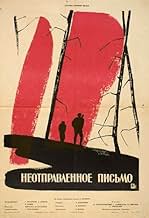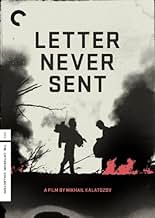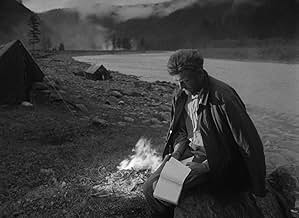CALIFICACIÓN DE IMDb
7.8/10
4.6 k
TU CALIFICACIÓN
Cuatro geólogos buscan diamantes en el desierto de Siberia.Cuatro geólogos buscan diamantes en el desierto de Siberia.Cuatro geólogos buscan diamantes en el desierto de Siberia.
- Dirección
- Guionistas
- Elenco
- Premios
- 1 nominación en total
Innokentiy Smoktunovskiy
- Konstantin Sabinin
- (as I. Smoktunovskiy)
Tatyana Samoylova
- Tanya
- (as T. Samoylova)
Vasiliy Livanov
- Andrey
- (as V. Livanov)
Evgeniy Urbanskiy
- Sergey Stepanovich
- (as Ye. Urbanskiy)
Galina Kozhakina
- Vera
- (as G. Kozhakina)
Opiniones destacadas
Loss, purpose, and redemption, all in this harrowing adventure and visual tour-de-force by usual suspects Kalatozov/ Urusevsky.
An expedition of diamond hunters is dropped in the Siberian plateau with the mission of discovering a rumoured diamond vein. In the course of the movie diamonds acquire a further symbolic aspect as the purpose in life. As the expedition is befallen by a raging fire and forced to make a hazardous escape through burning logs, saving the map which points to the location of the much sought-after diamonds becomes a struggle to preserve purpose and meaning in a world that defies it. As the surviving members of the expedition stagger through the charred landscape, amidst billows of smoke and torrents of rain, nothing there to answer their pleas and curses but the echo of their voices, the world seems indifferent to their plight.
The star of the movie however is Urusevsky's cinematography. Kalatozov fails to harness his tremendous visual talent as he did in THE CRANES ARE FLYING, certain scenes flailing for attention but lacking the dramatic pull to justify them, but still someone who likes movies for their pictorial quality, for the endless possibilities of capturing images with a photographic lens and moving inside a thridimensional canvas; such a person will be left in awe and admiration of what Urusevsky achieves. His rapid tracking shots through branches of trees, as though the nature conspires to ensnare the protagonists, the amazing clarity of the closeups, the maize of hand-held shots thrusting the viewer right there in the middle of the action, the beautiful dutch angles transforming the geography of the landscape into something that can only exist for and by the camera.
Although the plot has its heart in the right place, much like its predecessor, it suffers from being too overwrought and from lapsing into moments of melodrama. Plot threads that are emphasized early on, like Sergei's unrequisite love and the growing tension with Tanya, are never really resolved and come to a screeching halt when the fire erupts. Traditional Soviet values, like the leader's dream of a Diamond City and the portrayal of civilization as a collective good, don't chime with my sensibilities. The score is often jarring and obtrusive but that's 50's cinema for you.
Overall this is a visually marvellous film aimed at the cinephiles who can appreciate such things.
An expedition of diamond hunters is dropped in the Siberian plateau with the mission of discovering a rumoured diamond vein. In the course of the movie diamonds acquire a further symbolic aspect as the purpose in life. As the expedition is befallen by a raging fire and forced to make a hazardous escape through burning logs, saving the map which points to the location of the much sought-after diamonds becomes a struggle to preserve purpose and meaning in a world that defies it. As the surviving members of the expedition stagger through the charred landscape, amidst billows of smoke and torrents of rain, nothing there to answer their pleas and curses but the echo of their voices, the world seems indifferent to their plight.
The star of the movie however is Urusevsky's cinematography. Kalatozov fails to harness his tremendous visual talent as he did in THE CRANES ARE FLYING, certain scenes flailing for attention but lacking the dramatic pull to justify them, but still someone who likes movies for their pictorial quality, for the endless possibilities of capturing images with a photographic lens and moving inside a thridimensional canvas; such a person will be left in awe and admiration of what Urusevsky achieves. His rapid tracking shots through branches of trees, as though the nature conspires to ensnare the protagonists, the amazing clarity of the closeups, the maize of hand-held shots thrusting the viewer right there in the middle of the action, the beautiful dutch angles transforming the geography of the landscape into something that can only exist for and by the camera.
Although the plot has its heart in the right place, much like its predecessor, it suffers from being too overwrought and from lapsing into moments of melodrama. Plot threads that are emphasized early on, like Sergei's unrequisite love and the growing tension with Tanya, are never really resolved and come to a screeching halt when the fire erupts. Traditional Soviet values, like the leader's dream of a Diamond City and the portrayal of civilization as a collective good, don't chime with my sensibilities. The score is often jarring and obtrusive but that's 50's cinema for you.
Overall this is a visually marvellous film aimed at the cinephiles who can appreciate such things.
Saw this at Tribeca Film Festival in Spring 2007, and was absolutely floored. I walked out of the theater afterword amazed at what I'd seen and thrilled that such an amazing film existed and had been maintained by a tiny number of appreciators in such excellent quality for so long.
The story is not the strong point of the movie. Rather, as with Terence Malick films, the story is just a starting point for the film, which is another beast entirely. What shines and carries the film from scene to scene is the cinematography. I didn't know if this was happened elsewhere at the time, but I didn't expect to see hand-held camera work in a 1959 Russian film, let alone the kind of early spinning, impossibly-filmed shot that appears early in the film. Later, there is a sequence that makes me long to know how they created the opportunity to film in such conditions.
If you've read this far, you must track down this movie. My understanding is that Francis Coppola has a California archive maintain the only copy in the Americas, and that it's usually shown just one a year.
The story is not the strong point of the movie. Rather, as with Terence Malick films, the story is just a starting point for the film, which is another beast entirely. What shines and carries the film from scene to scene is the cinematography. I didn't know if this was happened elsewhere at the time, but I didn't expect to see hand-held camera work in a 1959 Russian film, let alone the kind of early spinning, impossibly-filmed shot that appears early in the film. Later, there is a sequence that makes me long to know how they created the opportunity to film in such conditions.
If you've read this far, you must track down this movie. My understanding is that Francis Coppola has a California archive maintain the only copy in the Americas, and that it's usually shown just one a year.
Stunning cinematography in the Siberian taiga is the highlight here, with scenes like the dramatic/scary forest fire and ice floe accentuated by artistic camera work, including some nifty handheld shots. It's a survival story, one in which a quartet of explorers go out into the rugged wilderness in the hopes of finding diamonds to help the technological advancement of the Soviet state, but find themselves imperiled by the merciless forces of nature. Director Mikhail Kalatozov and cinematographer Sergey Urusevsky made a beautiful film here, one that for the visuals alone made it well worth seeing.
Where the film fell a little short for me was in how forced a couple of its aspects were. The first was the romantic angles, with Tatiana Samoilova and Vasily Livanov playing the two geologists on the mission who are also in love. While that could have added depth to the story and I would watch Samoilova in pretty much anything, the dialogue seemed so inauthentic that it pulled me out of feeling any kind of emotion for the two, or the tension of jealousy from a third man, played by Yevgeni Urbansky. I felt the same way about the titular framing for the story, a letter being composed by the guide (Innokenty Smoktunovsky).
The second aspect that took away from the experience was how heavy-handed the allegory was, with the clear message of perseverance, courage, and sacrifice for the greater good of the Fatherland. This was a story that needed gritty realism in every respect; we get it from the natural elements, but not always with the people, which was unfortunate. Had it been otherwise, this would have been a masterpiece.
Where the film fell a little short for me was in how forced a couple of its aspects were. The first was the romantic angles, with Tatiana Samoilova and Vasily Livanov playing the two geologists on the mission who are also in love. While that could have added depth to the story and I would watch Samoilova in pretty much anything, the dialogue seemed so inauthentic that it pulled me out of feeling any kind of emotion for the two, or the tension of jealousy from a third man, played by Yevgeni Urbansky. I felt the same way about the titular framing for the story, a letter being composed by the guide (Innokenty Smoktunovsky).
The second aspect that took away from the experience was how heavy-handed the allegory was, with the clear message of perseverance, courage, and sacrifice for the greater good of the Fatherland. This was a story that needed gritty realism in every respect; we get it from the natural elements, but not always with the people, which was unfortunate. Had it been otherwise, this would have been a masterpiece.
A quite ridiculous film about diamond hunters in Siberia by the extraordinary director/cinematographer team of "I Am Cuba" and "The Cranes Are Flying." Needless say, the camerawork in the bizarrely surreal and barren Siberian locations is UNBELIEVABLE (the continuous takes are longer than any other film in history except for "I Am Cuba") but the film itself is too directly tied to dramatic 'adventure story' conventions to transcend into pure poetry like "Cranes" and "Cuba." There is a spectacular scene shot with the main actors amidst a raging forest fire and another one shot during an ice-storm. Most definitely worth transferring to DVD (there isn't a true film fan that wouldn't be flabergasted by the cinematography) but not by the same ones (Hen's Tooth) who did such a mediocre job on the transfer of "I Am Cuba."
This robust survival adventure follows a team of Soviet geologists stranded in the wilderness of Siberia after a forest fire severs their communication link with civilization. The opening dedication to Socialist heroes everywhere and the noble sacrifices made by each character carry the story dangerously close to propaganda, but the intensity of their ordeal (through smoke and fire, over snow and ice, across mountains and tundra) thankfully overwhelms the political simplicity of the script. Unfortunately, it also overwhelms the initial hints of tension between each of the four characters (three male, one female) after the struggle to survive becomes paramount. The sense of isolation and exposure is numbing; the film was directed with a strong sense of visual drama (including more than one knockout montage), showing everything an audience would ever want to know about being lost in Siberia.
¿Sabías que…?
- TriviaIn 1995 the film was restored by and shown in United States upon the financial support from Francis Coppola.
- Citas
Andrey: Sergei, you've fallen in love with a girl who loves someone else, and that man loves her. From the moral standpoint it's wrong.
Sergey Stepanovich: I don't give a damn about your bookish morale. I'm in love.
Andrey: That's an egoist speaking.
- ConexionesFeatured in Fejezetek a film történetéböl: A szovjet film 1953-1970 (1990)
Selecciones populares
Inicia sesión para calificar y agrega a la lista de videos para obtener recomendaciones personalizadas
- How long is Letter Never Sent?Con tecnología de Alexa
Detalles
- Fecha de lanzamiento
- País de origen
- Sitio oficial
- Idioma
- También se conoce como
- Letter Never Sent
- Locaciones de filmación
- Mosfilm Studios, Moscú, Rusia(Studio)
- Productora
- Ver más créditos de la compañía en IMDbPro
- Tiempo de ejecución1 hora 36 minutos
- Color
- Mezcla de sonido
- Relación de aspecto
- 1.37 : 1
Contribuir a esta página
Sugiere una edición o agrega el contenido que falta

Principales brechas de datos
By what name was La carta que no se envió (1960) officially released in India in English?
Responda
























